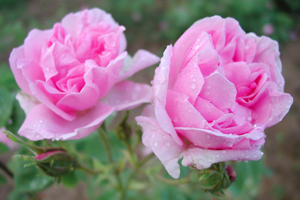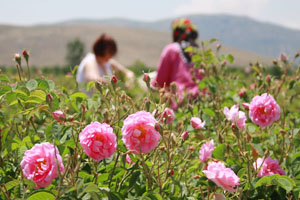Rose Otto – Why It’s The Finest Essential Oil For Skin Care
 There can be no other flower so widely revered throughout the ancient world in literature, art and legend, as the fragrant rose.
There can be no other flower so widely revered throughout the ancient world in literature, art and legend, as the fragrant rose.
And since records began the rose has also been employed in medicine by the ancient and highly advanced cultures such as the Arab, Assyrian, Chinese, Greek, Indian, Persian and Roman.
Eventually, the collective knowledge of these influential empires was carried further west to Europe, eventually arriving in France and England.
Of course today, rose oil is used by virtually all who enjoy the art of aromatherapy because of its vast range of therapeutic benefits and beautiful aroma. When all else fails to please, you can be sure that the soothing, balancing and uplifting fragrance of rose oil will bring delight. And of all the rose oils available to lovers of aromatherapy, rose otto is arguably the most delightful.
Labour of love
In Bulgaria from the middle of May, rose blossoms are painstakingly picked by hand for up to 4 weeks until all the fields in the’ Valley of the Roses’ have been stripped of their flowers. By the time the job has been completed it will have taken almost a month of back-breaking work to pick all the flowers by hand in the time-honoured way.
Starting at 5.00am every morning while the dew is still on the flowers, the workers pick the blossoms non-stop until around 10.00am. Bags bursting full of fragrant flowers are then hauled off to the distillery to turn them into the precious rose otto we all love so much in aromatherapy. In Turkey around the same time of year exactly the same procedure is taking place when the same species of rose flowers, Rosa damascena forma trigintipetala are harvested and distilled to produce Turkish rose otto.
Amazingly, despite roses being grown all around the world in huge quantities, it is only in Bulgaria and Turkey that the correct type of soil and climate can be found to successfully grow the species of roses that produces high quality rose otto. During the 16th century, Ottoman (Turkish) merchants imported R. damascena for cultivation throughout the Balkan countries, including a newly founded town in Bulgaria that would eventually become known as Kazanlak. Kazan is the Turkish word for “still”, and Kazanlak literally means ‘the place of stills’.
Rose otto – the oil of eternal youth
Rose otto is a beautifully fragrant oil that is often described as the ultimate feminine oil, since it is invaluable for all types of gynaecological, menstrual cycle and menopausal problems. During such times of physical and emotional upheaval, this oil should be your number one choice since it regulates menstruation, eases cramps and balances negative emotions such as anxiety, fear (of change) and all forms of impatient and snappish behaviour!
Rose otto also tones the digestive and vascular system with a stimulating effect that increases the circulation, and a cleansing action that promotes the elimination of toxins. Speaking of stimulation; it was said that Cleopatra procured Mark Anthony’s love by adorning her bedroom floor and bed with rose petals, therefore it comes as no surprise that rose oil is considered an effective aphrodisiac.
Rose oil for skin care
Impressive as all this is, it is in skin care that rose otto oil truly excels, and not only for its beautiful, feminine aroma. There is no finer essential oil for mature or dry skin in need of deep moisturisation. It soothes, softens and hydrates the skin whilst bringing a tonic and toning action that helps to strengthen the collagen-elastin network. This network is what keeps your skin soft, supple, radiant and young-looking.
This toning action delivers a boost to tired, lifeless skin that is need of rejuvenation, and balances combination skin. It is absolutely unsurpassed when treating dry, mature or ageing skin in need of deep moisturisation and nourishment.
Rose otto, which is also known as ‘Attar of Roses’, is renowned for its powerful anti-aging properties due to its ability to fight free radicals and stimulate collagen production which helps to reduce fine lines and wrinkles. Its mild astringent action is effective in reducing and fading those unsightly broken capillaries (spider veins) and red patches when you use it regularly in your skin care routine. Just add a few drops of this precious oil to a cream or lotion base and you will both see and feel improvements in the tone, softness and radiance of your skin.
It is no accident that rose oil is still included in all high-class perfumes, toiletries and skin care products – women throughout the Middle East had discovered the benefits of rose long before the birth of Christ. It is only during the past several hundred years in the western world that we’ve learned to appreciate the true value of what is known as the ‘queen of flower oils’.
These are the reasons why we have continued to use rose otto in the skin care products we have manufactured for over 30 years, such a our Damask Rose Facial Hydrating Lotion. There is simply no other essential oil that offers all the skin-enhancing benefits of rose otto when used in natural skin care. If there was, then we would use that one instead!
Copyright © Quinessence Aromatherapy Ltd 2020. Written by Geoff Lyth
















